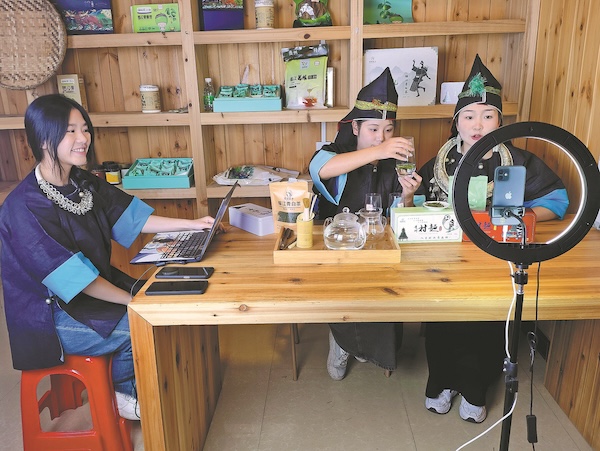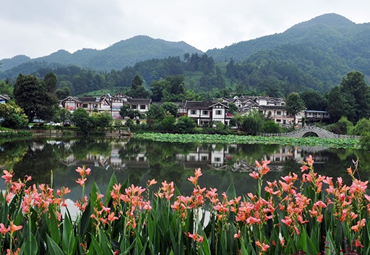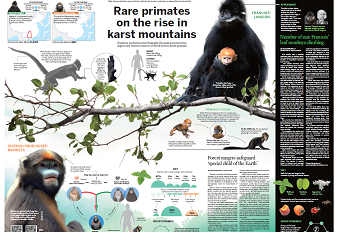Guizhou region sets example for rural vitalization success

Anchors sell local products in the new media cultural creativity industry park in Rongjiang county, Guizhou province. [Photo provided to China Daily]
Six years after China proposed its rural vitalization strategy, Guizhou province has emerged as a noteworthy example of success by boosting agricultural production and new media promotion, paving the way for a brighter future.
The challenging terrain of Guizhou, in southwestern China, poses a severe challenge to agricultural production, with data from the provincial forestry bureau showing that 92.5 percent of its land is mountains and hills, making flatland extremely valuable.
Covering an area of 700 hectares, the Chejiang flatland in Rongjiang county has attracted 26 market entities to engage in agricultural production. Peppers, tomatoes, cucumbers, luffas, eggplants and other vegetables are grown on a large scale and sold to vendors in the Guangdong-Hong Kong-Macao Greater Bay Area.
"We are grateful to receive help in marketing and technology from Foshan city's Nanhai district," said Qiu Jinyu, deputy general manager of an agricultural production company in the county. "As transportation facilities improve, vegetables from Rongjiang can arrive in the Greater Bay Area within a day."
Agricultural production on the flatland is boosting residents' incomes. They receive 24,375 yuan ($3,419) per hectare a year from the transfer of land use rights and can work as vegetable farmers.
"During harvest season, the flatland provides more than 20,000 job opportunities to residents," Qiu said.
Since 2021, Rongjiang has helped local companies establish cooperative business relations with counterparts in Guangdong province that have resulted in the sale of 160,000 metric tons of vegetables valued at around 500 million yuan, Tianyan News, a news outlet in Guizhou, reported.
Several regions in China went viral last year because of local attractions.
In Zibo county, Shandong province, it was barbecue, while in the city of Jiangmen in Guangdong, it was the television series The Knockout. Rongjiang county went viral thanks to the Rongjiang Village Super League — a soccer competition dubbed cunchao by netizens.
Behind the viral success stories, new media promotion helps cities and counties stand out and inspires less-developed parts of the country to catch up. Promotion efforts require professional new media teams, and Rongjiang trains them.
Established in November 2021, a new media cultural creativity industry park in the county features a talent training base, livestreaming center, product workshop and storage and logistics facilities. It aims to turn cellphones into new farm tools, data into new agricultural materials and livestreaming into new farm work.
The park has attracted more than 40 enterprises, provided training to 35,000 people, and helped over 8,000 people increase their incomes. It also cultivated about 2,200 livestreaming marketing teams, making it a valuable business model.
A county government work report released last year said the park sold more than 400,000 tons of agricultural products online in 2022.
Ouyang Zhangwei, who has business interests in the beverage and homestay industries, joined the park about a month after its establishment.
When he arrived in Rongjiang, Ouyang told residents he and his staff would teach them e-commerce operations free of charge.
"Our training consists of two parts: content production and livestream marketing," he said. "We train anchors according to their personality and products. Generally, it takes seven to eight months."
He has trained 26 anchors to sell agricultural products so far.
Gastrodia elata, an orchid commonly used in traditional Chinese medicine, is an excellent example of his efforts to boost rural vitalization through new media platforms such as Douyin, the Chinese version of short video app TikTok.
"Gastrodia elata sales are now over 30,000 yuan a day, topping the Guizhou agricultural product ranking list on Douyin," Ouyang said. "On Oct 25, gastrodia elata sales on Douyin reached 372,100 yuan.
"After the orchid exploded in popularity in 2022, Jihua town in Rongjiang decided to expand its planting area. This year, all gastrodia elata in the area will be sold by my team. Apart from the plant, we also sell its processed products like noodles and shampoo."
Ouyang said he has developed over 40 cunchao-related cultural and creative products, including soft drinks and bayberry juice. By leveraging the popularity of the Rongjiang Village Super League, he has made them hot-selling products.
He has also invested in local tourism. Xiaodanjiang Miao village, a traditional village in Rongjiang, boasts an untouched forest, a waterfall and the culture of the Miao ethnic group.
"That's why we invested in the homestay and marketed it," he said. "Residents told us there are so many tourists that they don't have enough reception capacity."
Ouyang plans to find more agricultural products with local advantages that he can sell in large quantities while also redoubling his efforts to develop cultural tourism.
京ICP备13028878号-8







 Overview
Overview Guiyang
Guiyang Guian New Area
Guian New Area Liupanshui
Liupanshui Anshun
Anshun Qianxinan
Qianxinan Qiandongnan
Qiandongnan Qiannan
Qiannan Zunyi
Zunyi Tongren
Tongren Bijie
Bijie Guizhou fosters cross-cultural bonds in Europe
Guizhou fosters cross-cultural bonds in Europe 18th Guizhou Tourism Industry Development Conference
18th Guizhou Tourism Industry Development Conference  Discover natural beauty in Qiannan, Guizhou
Discover natural beauty in Qiannan, Guizhou 

